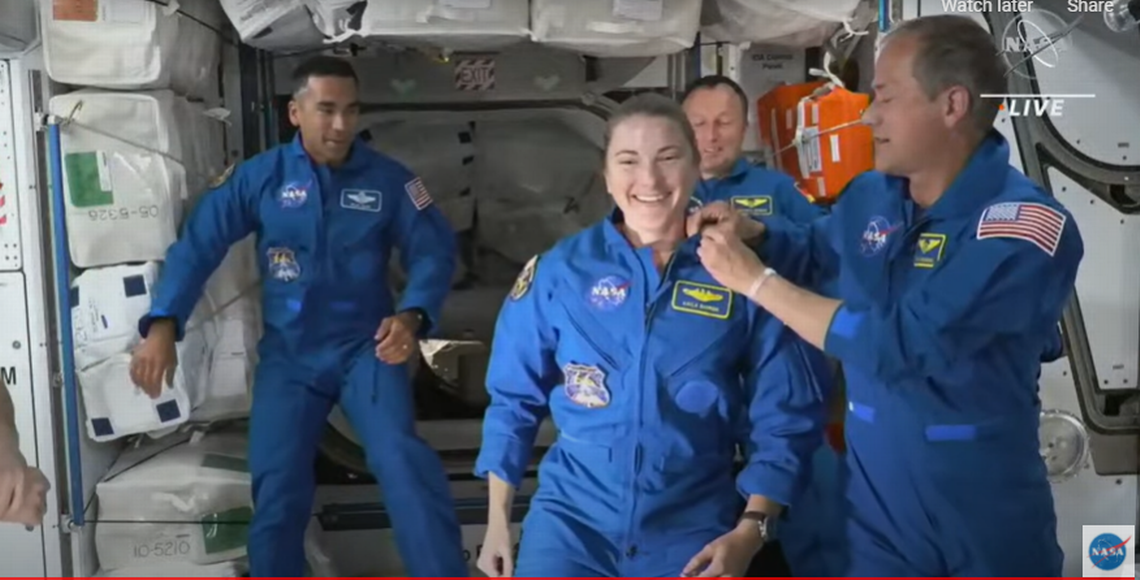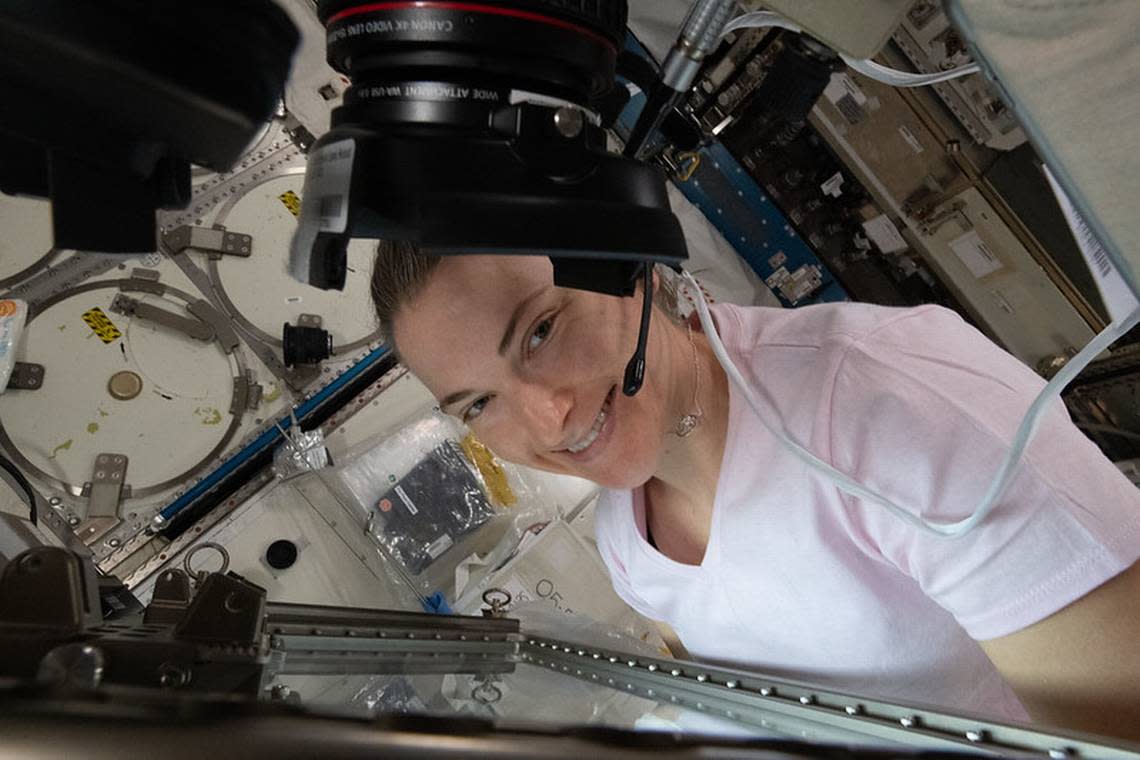Tri-Cities NASA astronaut returned to her high school. Here’s what students wanted to know
Retired Richland teacher Reed Spencer believes one of his former AP chemistry students is “moon material.”
And he’s not talking about rocks — he thinks she may just be the first woman to walk on the moon.
Lt. Commander Kayla Barron — a NASA astronaut who most recently spent 6 months conducting research on the International Space Station — is back in the Tri-Cities this week for a series of educational talks, mostly at public schools and at WSU Tri-Cities.
Her first stop on Tuesday landed her back at her alma mater, Richland High School.
“She was a leader and she was good,” Spencer, 73, said. “But that girl has confidence and it shows in everything she says. And I think that’s true for every high school kid in America: Your confidence comes after you have experiences and you accomplish what you set out to do when you have doubts.”
It’s been almost a decade since Barron, a 2006 Richland grad, was back at her old school. One of the last times she was there, she spoke to one of Spencer’s classes as a U.S. Naval Academy recruit.
“It’s just nice to be back in my hometown,” Barron said. “I think the Tri-Cities community, Richland in particular, my teachers, coaches, mentors, friends here were just such a big part of me developing the confidence I needed to chase big dreams and goals along the way.”
Barron spoke to packed auditorium about living on the ISS, conducting experiments, how she became an astronaut and what’s next for her.
“Putting yourself out there is the most important part,” she said, as dozens of students raised their hands to ask questions.
She also spent some talking time with about 60 high-level STEM, physics and chemistry students.
Growing up, she never imagined herself as an astronaut. But challenging herself in the military and surrounding herself with professionals helped guide her to her current career path.
“The only thing you really have to do if you want to become an astronaut is to have a degree in STEM. There are totally different pathways to arrive in a blue flight suit and talking in a high school auditorium,” she said. “For me, that was the military, studying engineering, working in an operational field.”
“But we have Martian geologists, we have microbiologists, we have physicians, we have military pilots — we have people from all walks,” she said. “And I think what unites us is (besides) from the fact that we studied STEM, but really our passion for working on teams.”
Barron’s also was scheduled to visit with students at River’s Edge High School, Pasco School District fourth-graders, and WSU Tri-Cities students and faculty. She also spoke at Tuesday night’s first annual STEM Connections Gala for teaching professionals.

Steve Fisk, Richland High School Principal, said in a news release that he hopes students understand “anything is possible if you set goals, work hard and persist. For our female students, they will see a Bomber graduate who has made history and demonstrates what it means to be a female leader in the modern age.”
Her tour was made possible thanks to the SILAS Education nonprofit.
Barron has a bachelor’s degree in systems engineering from the Naval Academy and also earned a master’s degree in nuclear engineering from the University of Cambridge, England, as a Gates Cambridge Scholar. She was stationed for three years on the USS Maine submarine and served three deployments in the Pacific Ocean.
Barron is also set to talk at the Richland Public Library at 7 p.m. Thursday as part of the Community Lecture Series offered through the Columbia Basin College Arts Center.
Admission is free but space is limited and seating is first-come, first-served. It also will be streamed on Zoom by going to bit.ly/Barrontalk with meeting ID 811 7157 1297 or via telephone by calling 253-215-8782 or 206-337-9723.

Inquiring minds
During her stay on the ISS, Barron’s team conducted more than 350 experiments.
Richland High School students had some intriguing questions for Barron:
What entertainment is there at the ISS?
Astronauts have “almost constant” internet access, so it’s easy to download movies, television shows and music.
Weirdest thing for her to get used to while living in zero gravity?
Living in micro gravity is fun but also hard, Barron said. You have to adjust to a whole new lifestyle and way of living. “You’re kind of like a baby again, learning how to live in space. You have to learn how to move around, move your body. You have to learn how to keep track of a lot of your stuff. So, you have to develop a whole bunch of brand new habits that are second nature by the time you’ve been up there for a couple months. But those first couple weeks? All bets are off.”
Was the adjustment from zero gravity to earth gravity hard?
For Barron, the transition home was more difficult than coming onto the ISS. She couldn’t walk for the first couple hours of being back on earth. Her neurovestibular signals, which function as a frame of reference to her senses, were thrown out of whack — she had to regain her earth coordination and fought through vertigo.
Can you talk with family?
Barron said she had weekly video conferencing with her family while on the ISS. It’s much better than being on a submarine.
Are there any political tensions or rules between countries doing research at ISS?
Barron said the crew’s shared mission of research and international cooperation largely eclipses any geopolitical fissures that may be ongoing. Her tenure on the ISS overlapped with the Russian invasion of Ukraine, but that event didn’t impact their cooperation. “We develop really deep, meaningful relationships with these colleagues.”
Has her time in space affected her perspective of sci-fi or space movies?
Not a great deal, she said. Her favorite space movie is still “Apollo 13.” Despite their accuracy flaws, space media can be helpful to “inspire people what they think is possible.”
What was her biggest obstacle?
“The fear of failure. I think it’s really easy to dream big and harder to pursue those dreams because you have to accept the possibility that you might not get where you’re hoping to go, or that you’ll put yourself out there and maybe stumble and fall and do that in front of a lot of people,” she said. But thankfully, she said, she had a network of support.
New moon launch date
NASA plans to return Americans to the moon by 2024, including the first woman and first person of color who will walk the moon. Barron serves on NASA’s Artemis Team — a group of astronauts who will continue work and research on the moon and Mars.
Artemis 1, the team’s first lunar mission — an unmanned one — will test all the systems that will take Americans back to the moon. It’s launch date, which has seen delays, is currently set for Sept. 27.
Barron will depart the Tri-Cities on Friday for Houston to get some rest before pivoting her focus to Artemis 1.
“We’re excited to go back and we’re going back in a different way this time,” she said. “We’re not going back to just visit a tiny, little portion of the moon and leave, we’re going back to stay. We’re going to have a permanent human presence on the moon.”
Barron said she will likely have several different roles in the Artemis project. It’s hard for her to wrap her mind around possibly walking on the moon, and she hopes everyone on the team will get the opportunity to do so over the lifespan of Artemis.
“It’s hard to imagine being that far from home, but we’re going to do it. And that’s just the incredible nature of the space business, especially the international cooperation that we have as part of the astronaut program. We’re going to bring the best of minds, the best operational thinkers to bear on these programs,” she said.
“Stay tuned — we’re going to do some awesome stuff with Artemis.”
